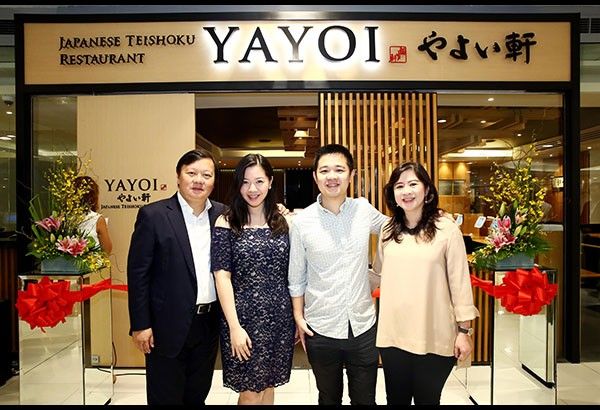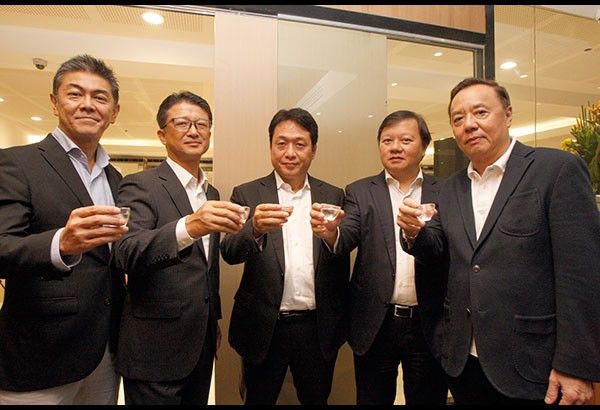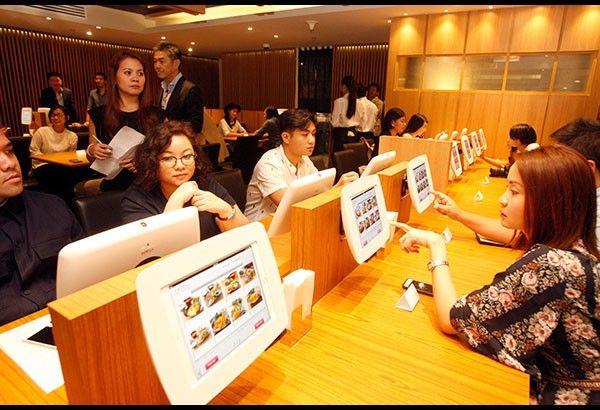Yayoi: A blend of ceremonial grace and convenient gadgetry

I relearned a Japanese word recently: teishoku. It means “meal set” and is based on the ichiju-issai (or “one soup, one side”) traditional meals offered at Zen temples, which include a main, soup, rice and pickles. It may not be a new concept (especially to many Filipinos who are not newbies to ceremonially prepared Japanese cuisine), but my taste buds were caught by surprise when I had a teishoku meal at the newly opened Yayoi Japanese Teishoku Restaurant in SM Megamall.
My meticulous little receptors were duly impressed (and believe me, they’ve tasted everything from sisig to haggis). I ordered the Sukiyaki Teishoku: the udon noodles were cooked just right — al dente in the center, soft and slippery on the outside — with strips of soft beef dipped in half-cooked egg (or malasado) and tasty veggies, washed down with Japanese beer (actually, two). And I heard that the udon is accurately prepared: order this dish any day of the week at Yayoi and you’re guaranteed of its consistency.
“My favorite (among the dishes) is the Namban Teishoku — fried chicken steak in sweet sauce topped with a special Yayoi tartar sauce,” shares Yvonne Yao. Yvonne is one of the managing directors of Yayoi Philippines, along with Jacqueline Gobing and John Gobing. Some time ago, the Yao and Gobing families were on holiday in Fukuoka, Japan, and stumbled upon a restaurant across their hotel.
“It was early in the morning and only Yayoi was open,” Yvonne recalls. Curiously at first, there was just one server and everything was automated. They made their choices, got tickets, presented them to the server, and within 15 minutes out came the manna of set meals.
“It was fast, fresh, authentic Japanese food — the quality’s there,” enthuses Yvonne. “We hadn’t experienced anything like it. And we told ourselves, ‘This could really work in the Philippines.’”
The Yaos and Gobings looked into Yayoi’s parent company, Plenus Company Ltd. (which has been in the food business since 1980 and currently operates around 3,000 restaurants), and found out it was open to a partnership in the Philippines.
Plenus Co. president and CEO Tatsuo Shioi explains the rich history of Yayoi.
Following the Meiji Restoration, when Japan opened its doors to the world in the 19th century, cuisines from many different countries flooded into the country. These new flavors then gradually merged with Japan’s own traditional cuisine. (French cuisine was quite popular at that time.) During this period of transition in 1886, a Western food restaurant called Yayoi-ken opened in Tokyo’s Kayaba-cho. This much-loved restaurant, to which Yayoi traces its roots, played a hand in introducing contemporary Japanese food culture to many people.
The original business of Tatsuo and his father was in bento boxes (currently 2,700 shops all over Japan). “We found out about Yayoi-ken root, and that’s why we decided to do Yayoi — to honor the heritage,” shares Tatsuo (with his daughter Yoko, who is part of Plenus’ marketing division, acting as interpreter).
Even if Yayoi has outlets all over the world, Tatsuo and company were determined not to localize the flavors of the dishes at all. He says, “Fortunately, people overseas love authentic Japanese flavors, even if ingredients such as chicken and beef are sourced locally to retain their freshness. Items such as soy sauce and rice are imported from Japan.”
There is also an interactive way in which food is served at Yayoi. Each table is equipped with a tablet. Just skim through the digital menu, click your orders of food and drinks, and they are promptly served steaming hot from the kitchen. You can also pay your bill this way. No mix-ups and long waits. Ideal for peeps hurrying back to the office. And that’s how they roll in Japan.
They encountered that particular system when they visited Sydney. Tatsuo says, “We contacted the developer and had it installed in all Yayoi branches outside of Japan (which uses a different technology).”
Yoko says her father is a very quiet and patient businessman who is able to inspire the people around him in helping achieve common goals. The man even cooks for the family; okonomiyaki is his specialty.
Yvonne also looks up to her father — Ivan Yao, the president of Lucerne Group — as her role model in business. “My dad is a workaholic and he’s forward-thinking — always thinking of growth, of long-term goals, of the future. So, every day, I wake up and I make decisions based on the decisions he made when I was under his wing. I appreciate everything I’ve learned from him.”
Yvonne does love retail (not surprising since the family business revolves around Swiss luxury watches), but she is a self-confessed foodie.
She explains, “When I was a student in Sydney, Australia, and I didn’t have many friends yet since I was new to the country, I was usually glued to my laptop researching about ingredients, watching cooking shows on YouTube like MasterChef. I love food with a different kind of passion. So, when my dad said, ‘Oh, we’re bringing in Yayoi. You handle it…’ I readily accepted the challenge.”
Tatsuo Shioi says his partners in the Philippines have an eye for super-brands, so they must have seen something special in Yayoi.
Yvonne explains, “At Yayoi, we serve teishoku, which Filipinos love — the fact that it’s just at one price and you get all these different things on a tray. Everything is so well thought of. When we serve eel, we put wasabi and spring onions next to it — whatever complements the dish.”
The Japanese are delicate when it comes to the positioning of each piece in the set meals. “In our Mix Toji Teishoku, the shrimp is placed in the middle to divide the beef and pork portions. And the tail of the shrimp should not be facing the customer, to present it beautifully. There is an art to it.”
Yayoi’s next store will open early next year at Mall of Asia. Yvonne concludes, “We want to expand quickly so that more and more Filipinos will be able to try our teishoku. Our main goal is to put up 15 stores in five years.”
Thus, Yayoi is not just a restaurant that serves sukiyaki or miso katsu. Meals are set and ordered, yes. But the dreams and aspirations of these enterprising families are the ones delivered.










* * *
Yayoi is at the third-floor Bridgeway, SM Megamall B, Mandaluyong City. For information, visit www.yayoi.com.ph and follow Yayoi on Facebook (Yayoi Philippines) and Instagram (@yayoiph).



















